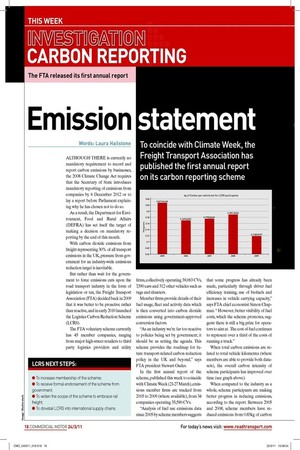Emission statement
Page 14

Page 15

If you've noticed an error in this article please click here to report it so we can fix it.
Words: Laura Hailstone
ALTHOUGH THERE is currently no mandatory requirement to record and report carbon emissions by businesses, the 2008 Climate Change Act requires that the Secretary of State introduces mandatory reporting of emissions from companies by 6 December 2012 or to lay a report before Parliament explaining why he has chosen not to do so.
As a result, the Department for Environment, Food and Rural Affairs (DEFRA) has set itself the target of making a decision on mandatory reporting by the end of this month.
With carbon dioxide emissions from freight representing 30% of all transport emissions in the UK, pressure from government for an industry-wide emissions reduction target is inevitable.
But rather than wait for the government to force emissions cuts upon the road transport industry in the form of legislation or tax, the Freight Transport Association (FTA) decided back in 2009 that it was better to be proactive rather than reactive, and in early 2010 launched the Logistics Carbon Reduction Scheme (LCRS).
The FTA voluntary scheme currently has 45 member companies, ranging from major high-street retailers to third party logistics providers and utility irms, collectively operating 39,063 CVs, 7,390 cars and 312 other vehicles such as tugs and shunters.
Member irms provide details of their fuel usage, leet and activity data which is then converted into carbon dioxide emissions using government-approved conversion factors.
“As an industry we’re far too reactive to policies being set by government; it should be us setting the agenda. This scheme provides the roadmap for future transport-related carbon reduction policy in the UK and beyond,” says FTA president Stewart Oades.
In the irst annual report of the scheme, published this week to coincide with Climate Week (21-27 March), emissions member irms are tracked from 2005 to 2009 (where available), from 34 companies operating 35,590 CVs.
“Analysis of fuel use emissions data since 2005 by scheme members suggests that some progress has already been made, particularly through driver fuel eficiency training, use of biofuels and increases in vehicle carrying capacity,” says FTA chief economist Simon Chapman. “ However, better visibility of fuel costs, which the scheme promotes, suggests there is still a big prize for operators to aim at. The cost of fuel continues to represent over a third of the costs of running a truck.” When total carbon emissions are related to total vehicle kilometres (where members are able to provide both datasets), the overall carbon intensity of scheme participants has improved over time (see graph above).
When compared to the industry as a whole, scheme participants are making better progress in reducing emissions, according to the report. Between 2005 and 2008, scheme members have reduced emissions from 0.83kg of carbon per vehicle to 0.79kg, while the freight industry as a whole has stayed relatively stagnant at 0.88kg of carbon per vehicle in 2005 to 0.89kg in 2008.
Following the publication of the irst annual report of the LCRS, member irms are committing collectively to an 8% reduction in the intensity of carbon dioxide emissions by 2015 (compared with 2010 levels). Future annual reports will monitor the progress towards meeting this target.
“The 8% intensity reduction in just ive years is challenging,” says Chapman.
“However, we believe it is achievable given the opportunities that alternative fuel and vehicle technology offer in improving fuel eficiency and the contribution that telematics and trafic ofice IT can make to working resources harder.” Chapman points out that unlike national carbon dioxide reduction targets, which commit the UK to an absolute cut in carbon dioxide emissions, the scheme’s target focuses on producing less carbon per unit of resource or activity.
“Setting an absolute cut in emissions, while supericially attractive as it would tie into national targets, is impractical. Freight demand and therefore absolute levels of fuel use is heavily dependent on economic growth and changes in business of scheme members.
“These are not factors that businesses can predict with any certainty. What operators can commit to is how they will make use of low carbon technologies and fuels and leveraging greater productivity out of their resources,” says Chapman.
In order to achieve a reduction, the report highlights ive operational parameters that are within the scope and budgetary authority of most transport managers to control: ● Freight modal split: proportion of freight moved by low carbon transport modes (rail and water); ● Empty running: proportion of lorry– kilometres run empty; ● Average payload weight: average weights of loads carried on laden trips; ● Fuel eficiency: ratio of fuel consumed to total distance travelled; ● Carbon intensity: proportion of low carbon fuels/energy sources used in the freight transport operation.
The idea is that these ive areas are practical measures that operators of all sizes can focus on to achieve a reduction over the next ive years.
Although the LCRS is industry-led, the FTA believes there is considerable potential for government support to reinforce the progress made by operators.
“If government wants more then they can help us by looking at higher capacity trucks, defending double-deck trailers against a possible European height limit of 4m, making rail freight cheaper and easier to use, restoring rail freight grants and biofuel duty incentives and most immediately freezing duty on diesel,” says Chapman. ■
● To download the report go to: www.fta.co.uk/lcrsreport














































